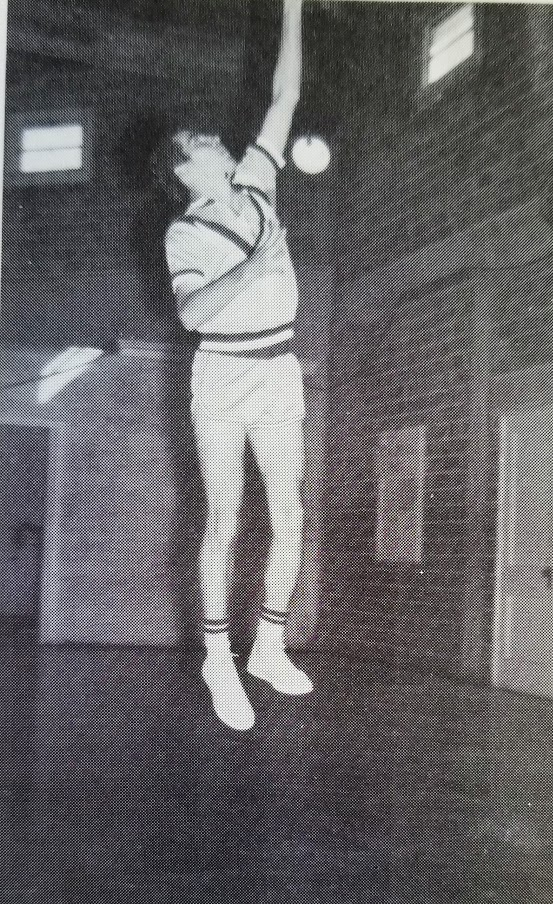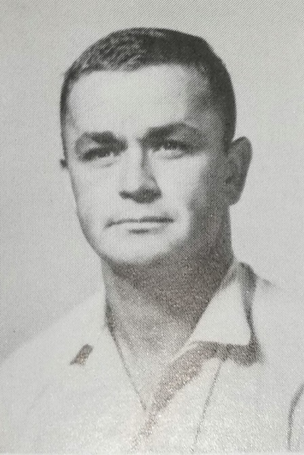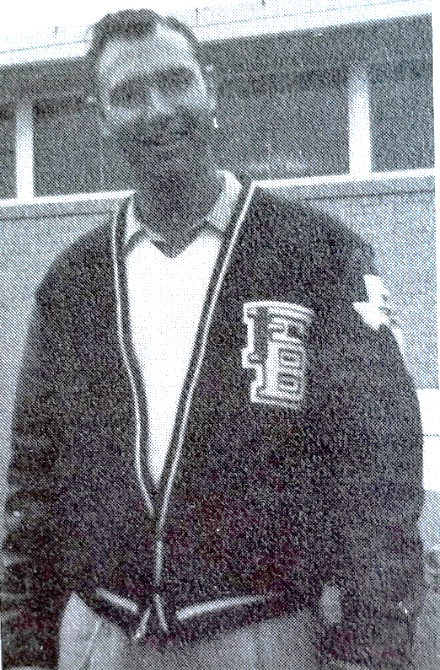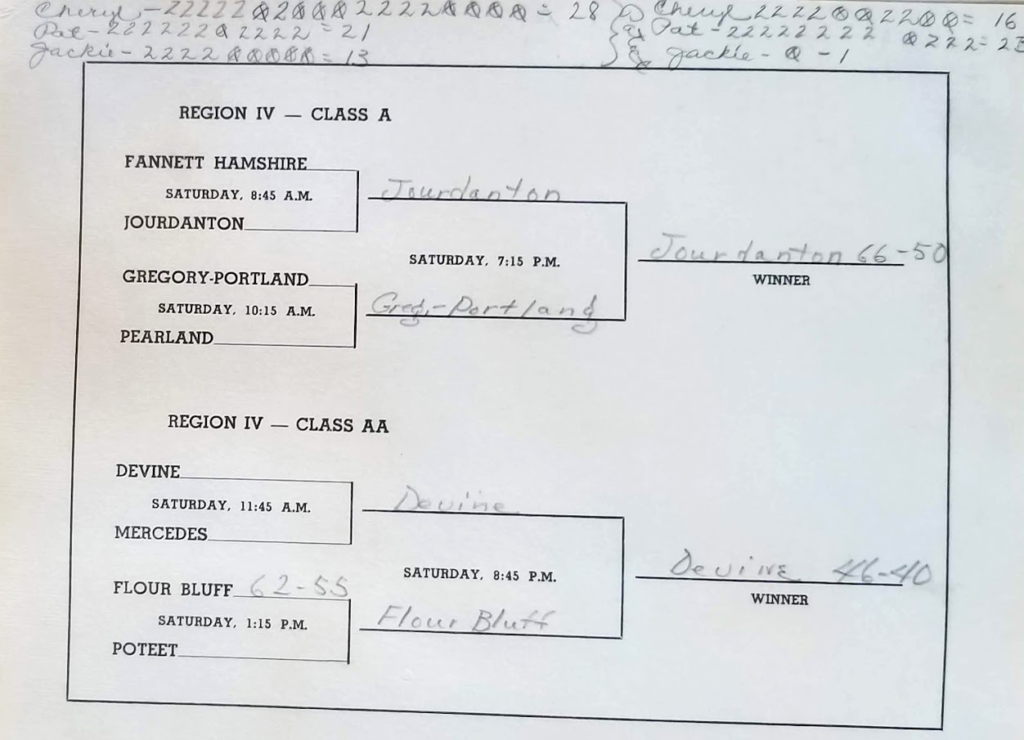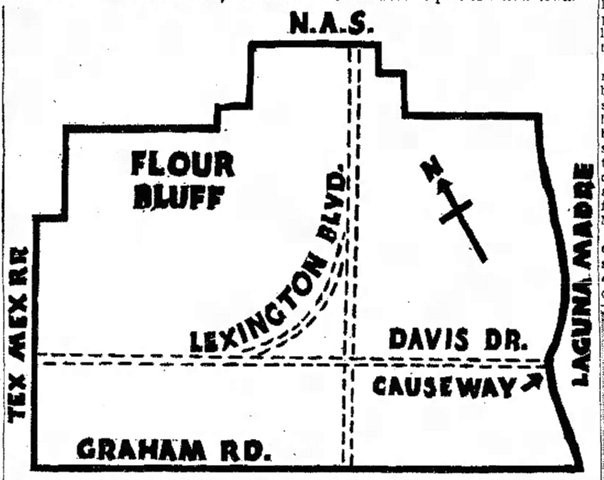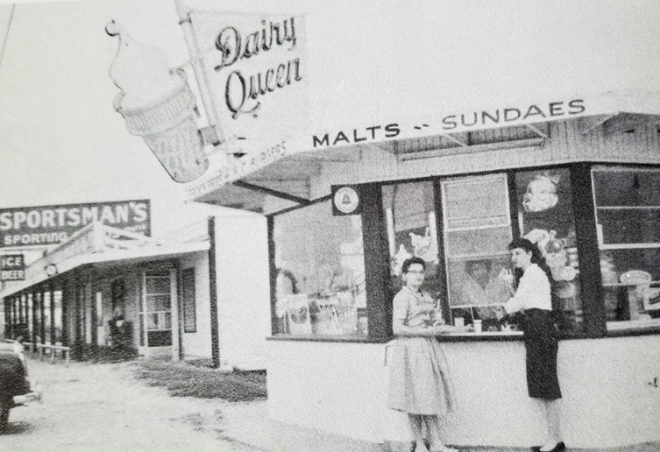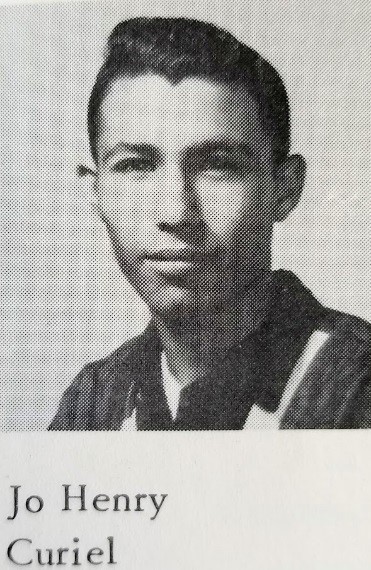[spacer height=”20px”]
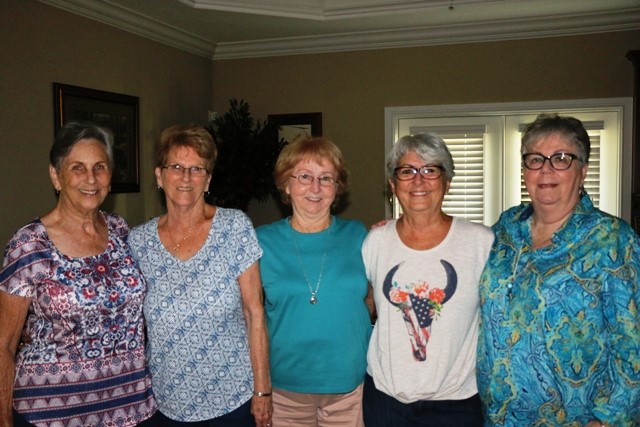
L to R: Jannette Smith Bollinger, Betty Jo (Jody) Armstrong Eleuterius, Connie Lynch, Cheryl Roper Beauregard, and Jackie Watson Johnson, 2018 (Photo by Shirley Thornton)
[spacer height=”20px”]
Sporting events have been at the heart of the Flour Bluff community since the 1930s. In this little town that almost was, baseball, volleyball, football, basketball, and even boxing brought everyone together to visit with each other and cheer on the team or a favorite athlete. By the 1950s, it was simply a way of life for the people who lived on the Encinal Peninsula, including Jannette Smith Bollinger, Betty Jo (Jody) Armstrong Eleuterius, Connie Lynch, Cheryl Roper Beauregard, and Jackie Watson Johnson. They had gone to school together since first grade, but it was school sports that gave them the common experiences that would continue to bring them together well into their golden years. Through their recollections, Cheryl’s scrapbooks, and Hornet yearbooks, it becomes quite clear that these ladies weren’t just some girls who dabbled in sports.
These were outdoor kids who spent little or no time watching television or sitting inside. Cheryl remembers how grass could never grow in her yard in Humble Camp because the kids were always outside playing basketball. The grass just didn’t get a chance to grow. Jackie talks of how the kids gathered up in a sand lot to play baseball. Though the girls played sports in the neighborhood, they didn’t play as a team until junior high. Jackie, a year younger, would not join the others on the court until they were all in high school. She earned a spot on the varsity team as a freshman and earned the respect of her teammates and coaches, as well.
“Butch Roper [Cheryl’s older brother] taught me how to shoot a left-handed and a right-handed hook,” said Jackie. “He was a very talented basketball player, and he taught me to play like a boy.”
[spacer height=”20px”]
[spacer height=”20px”]
“She was very good,” said Connie of her friend Jackie. “What made her so special on the court was her ability to shoot with either hand. Our opponents never knew which way she would go.”
Wendell Smith coached the girls all four years of high school. Superintendent E. J. Wranosky hired Smith to coach basketball; he just didn’t know Wranosky meant girls’ basketball. How surprised he must have been when that group of very talented freshmen girls stepped onto the court! The girls had proven themselves to be extraordinary athletes in junior high. The girls were coached by two of the best in their opinions, Coach Jack Johnston and his wife Marcella.
“They [Johnstons] really gave us a good foundation in the fundamentals of basketball,” said Jackie. “They taught us techniques that we carried with us into high school.”
“We drove Jack crazy!” said Cheryl. “He worried so much about how we played and if we won that I think we’re the ones who gave him ulcers. His wife was a good coach, too. If we won and played badly, we were in trouble. If we lost, we were only in trouble if we hadn’t played well. Marcella was really tough on us.” Coach Johnston passed away in 2016 in Van Buren, Arkansas.
[spacer height=”20px”]
[spacer height=”20px”]
The girls enjoyed their time with the Johnstons and learned a great deal. They remember Tuloso-Midway as their main adversary, and matter-of-factly said that they beat them. It was Coach Smith who would take the girls to the regional tournament in basketball and even coach them in tennis. Their memories of him and the games they played are fond ones.
[spacer height=”20px”]
[spacer height=”20px”]
“We went to Regionals, and that was a big deal for girls then,” said Cheryl. “We played Moulton – one of best teams around – in a tournament, and they told us that they would see us at State.”
“I was the tallest on our team,” said Jannette. “I’m just 5’7”. Our team did not have size.”
“I was the post,” said Jackie, “and I’m just 5’ 3”!”
Cheryl kept impeccable records on the wins, losses, and points scored by individual players. “We were district champs in 1962, which is how we got to the Regional finals. We lost to Devine, but we had our best season that year,” she said.
“Wendell Smith was more than our coach,” said Cheryl. “He was the best man ever. He was so good to his players. Gee, he even let Jody drive his car to lunch, and she didn’t even have a license!”
“I wound up in his fifth-period civics class, the one where the kids had to pass, or they wouldn’t graduate,” said Jannette. “I think he was working on his master’s degree at the time, and he actually let me teach class. He wrote all the questions for the test on the board on Monday. You spent the week looking up the answers and studying for Friday’s test. He didn’t really like teaching a class; he preferred coaching sports. But, he said that Mr. Wranosky would ask him if he wanted $100 a month more to do something else, and he did whatever it was.”
“He was my salvation,” said Jody. “When my mother remarried, we had to move to town for about six months. I rode with him back and forth to school. He was just great. I even babysat his kids.”
“He knew how special he was to all of us,” said Jannette, who also moved to town for a bit. “My dad married and moved us to town off Kostoryz. My sister, little brother, and I walked from our house to where Coach Smith lived off Weber every day, and he’d take us to school.”
“We liked his wife, Sally, too,” said Jody. “She worked for a law office, but she always looked so sophisticated that we thought she owned it. She was so calm and serene and gracious. She and Wendell were so giving to the kids even though they lived in town.”
Jackie added, “We all remained friends with him after graduation.”
Coach Wendell Smith, who was dearly loved and respected by his athletes, passed away on Friday, November 25, 2011, in San Antonio at the age of 84. These women have honored his memory by telling his story and letting others know how his kindness and generosity affected them their entire lives.
The girls were serious competitors on the basketball and tennis courts, but they were still teenagers growing up in a small town. Because they walked everywhere in Flour Bluff – something that most parents won’t allow their children to do today -they still remember the places that they visited or passed on their walks. They all agreed that “Main Street”, if there was one, was Lexington Boulevard. They painted a picture of the stores, cafés, and businesses as they spoke of each one. They listed them in order, starting on the east side of the road and moving toward the base: K&B Grocery (owned by Herman and Rosalee Bohuslau), Humble Camp (where Cheryl’s family lived), a barber shop, DeGashes General Store, Hawley’s Drug Store, Hawley’s Cleaners (where the Navy plane went down without touching the building), Wil-Mar Dairy Bar, and a car lot next to South Gate.
Flour Bluff incorporation map, 1950
[spacer height=”20px”]
Then, they made their turn at South Gate and listed the businesses on the west side from the base, down Lexington, and around the curve onto what is South Padre Island Drive today. This time they named Sally’s Beauty Shop, Mr. Rachel’s clothing store, the Pizza Cove that served the first pizza in Flour Bluff, a liquor store, the Laundromatic, South Gate Grocery (owned by Frank Buhider), Liberty Café (run by Jannette’s parents), Circle N Café (also run by Jannette’s parents), a doctor’s office with a lady doctor named Neubar, Dr. Hughes’ office, Avery’s 13-20 Club, which they remember being just at the big curve on Lexington, Morrow’s Garage, and the lumber yard.
“The 13-20 Club had been a restaurant many years before that,” said Jannette, referring to the 1320 Club. “They had sock hops there on Friday and Saturday nights.”
[spacer height=”20px”]
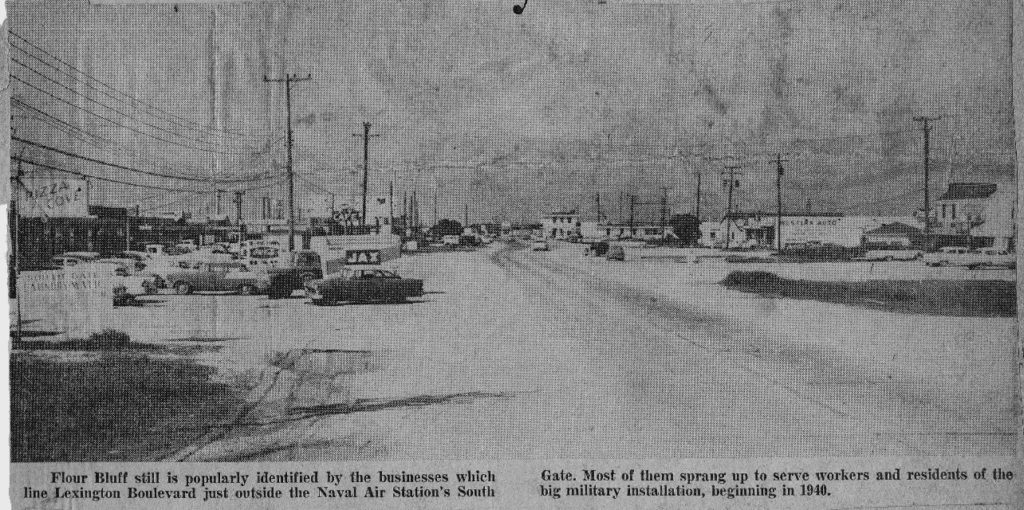
Corpus Christi Caller-Times newspaper clipping showing NAS Drive, where most of the businesses in Flour Bluff existed for many years. The south gate of the base can be seen at the far end of the road. Humble Camp sat on right just outside the base.
[spacer height=”20px”]
“And then there was the Dairy Queen,” said Connie, a statement that brought smiles to all their faces. “It’s where we all met and danced. There was a room in the back with a concrete floor. It had a jukebox and several booths. After games and on weekends, everybody met at the Dairy Queen. It was owned by the Odanovich family.”
Jody chimed in, “It was the place!”
The women laughed as they found themselves reliving memorable events from their youth. Once they cut school to go bowling and got caught when Cheryl asked her daddy for money. Some remembered getting spankings at home for that one, and Coach Smith made all of them copy from the dictionary. When Jody and her friend Helen skipped school to get their hair done to get ready for a dance, Coach Smith made them wash all the lockers. It must have been difficult to sneak around in a tiny community like Flour Bluff where everyone knew them or their parents or their teachers and coaches. “Gosh, we had so much fun!” said Jackie.
[spacer height=”20px”]
[spacer height=”20px”]
“We lived in the best generation,” continued Connie. “There were no drugs. A few of the bad guys drank, but girls didn’t drink or smoke.”
“We played sports, and we danced,” said Jackie.
Cheryl added with a chuckle, “Joe Henry Curiel taught everybody how to dance. He lived on Laguna Shores. He was a fisherman. He was the best dancer ever, and he taught all the boys how to dance. He drowned after we graduated from school. I think they said he got tangled up in his nets. I’ll never forget him.”
[spacer height=”20px”]
The school offered them opportunities that they would have never had at home. They went to HEB Camp and to Ouray, Colorado. “Most of the kids in Flour Bluff hadn’t been anywhere,” said Cheryl, “so it was a big deal to get to camp and to Ouray. Most of us had never seen snow.”
“When we went to Ouray, the boys discovered they could buy beer at 17,” said Jody. “I never saw them with it, but I heard them say that they had bought it and put it in the river to keep it cold.” This brought a round of laughter from the group.
“The buses broke down all the way to Ouray,” said Jackie chuckling. “But it was still a lot of fun.”
“What a wonderful man Mr. Wranosky was to give all of us those opportunities that we would have never had,” said Jannette.
“He even bused anyone who wanted to go over to the Cuddihy Field swimming pool,” said Connie.
“We were so fortunate to go to a small school,” said Jackie, “where we made friends that we’re still in contact with.”
Nearly sixty years have passed since these women were just girls growing up in Flour Bluff. Still, their roots are buried deep in the sandy soil. They are periodically drawn back to the little “town” that they called home, where they lived, played, fell in love, married, raised children, and where some have remained. Their love for the place, its people, their school and its teachers and coaches, and especially for each other teaches all of us the importance of friends, family, and familiar faces. Flour Bluff was and still is a great place to grow up, and these “forever friends” prove it every time they come together to meander through the days gone by.
_______________________________________________________
The writer welcomes all corrections or additions to the stories of Flour Bluff to assist in creating a clearer picture of the past. Please contact her at shirley.thornton3@sbcglobal.net to submit a story about the early days of Flour Bluff.

